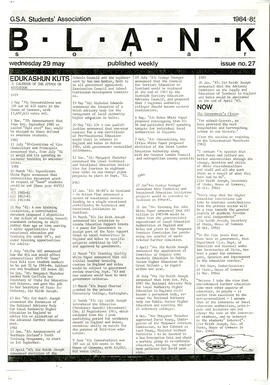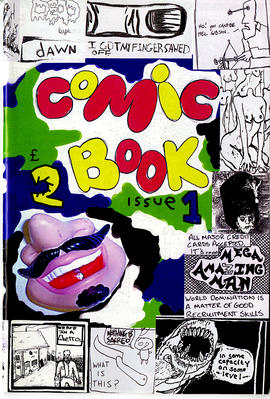- DC 009/4
- Subfonds
- 1984-2013
Part of Records of the Glasgow School of Art Students' Representative Council and GSA Student's Association
This collection includes two folders of material. The first, containing DC 009/4/1-9, includes publications produced by the G.S.A. Students’ Association between 1984 and 2005. The second, containing DC 009/4/10-21, includes publications created by students at the Glasgow School of Art, collected by the Students’ Association dating between 2003 and 2013.
• DC 009/4/1: Collection of GSA Students’ Association weekly publication ‘BLANK’ and other variations 1984-1985
• DC 009/4/2: Collection of GSA Students’ Association materials relating to Activities Week 1985
• DC/009/4/3: Collection of GSA Students’ Association weekly publication ‘SPANK’ 1985-1991
• DC/009/4/4: Two copies of newsletter ‘Stubble’, published 18 and 24 May 1988.
• DC 009/4/5: Copy of newsletter ‘TRASH’, Oct 1988
• DC 009/4/6: Copy of newsletter 'Think!', Jan 1990
• DC 009/4/7: Two copies of GSA Students’ Association 'Comic Book' issue 1, c 2000s
• DC 009/4/8: 'Fuse', Glasgow School of Art listings guide Issue 1, Jan 2001
• DC 009/4/9: Two copies of leaflet for 'AYE’, 15 Feb 2005-18 Feb 2005.
• DC 009/4/10: Copy of ‘FREAK’ Magazine, Dec 2003
• DC 009/4/11: Gallery of the bizarre, strange and the deranged magazine, 2004
• DC 009/4/12: 2 x Phreque magazine, 2004
• DC 009/4/13: Copy of ‘le magazine de BANG BANG’, Jul 2004
• DC 009/4/14: Copy of ‘PAVILION’ magazine, 2005
• DC 009/4/15: Copy of ‘THE CLAQUE’ Issue 1, ‘a collection of washroom images and unspoken words’, 2005
• DC 009/4/16: Two copies of comic ‘Things and Stuff’ no.2, April 2005
• DC 009/4/17: Your Order no. 1 magazine, Mar 2006
• DC 009/4/18: Milk Chocolate, 2007
• DC 009/4/19: 3 issues of Mammogram magazine, 2008 – 2009
• DC 009/4/20: Fold, Dec 2011
• DC 009/4/21: Undercurrents magazine, Issue 3, April 2013
The Glasgow School of Art


